Convergence
Embracing the Future with Network as a Service (NaaS)

Key Points
- NaaS enables developers to write applications that work across networks and network operators using a single, simple API.
- It streamlines communication and coordination between applications and the underlying network — improving network efficiency and reducing service complexity.
- This approach is more flexible, scalable and user-centric than other current solutions.
In our increasingly connected world, the demand for seamless, fast and efficient online experiences is growing at an unprecedented rate. Imagine a network where your services follow you, enabling an experience that is unique to you — wherever you are, on any device.
This is where Network as a Service (NaaS) steps in, promising to revolutionize the way we interact with the digital world. Let's dive into the what, why and how of NaaS.
Optimizing Online Experiences
In today’s home network, we are simultaneously connecting more devices and running more applications than ever before — all creating the countless online experiences we encounter every day.
What if we could manage these new experiences more efficiently, ensuring that the network is adapting to our needs? That’s precisely the goal NaaS aims to achieve.
By leveraging context awareness, NaaS enables a network that is more responsive to those different devices and applications while giving users a new level of control over their services.
The Impact of Enhancing Connectivity
Improving the underlying network infrastructure isn’t just about eliminating minor inconveniences. It's about unlocking a world of possibilities.
For users, that means an enhanced online experience with faster, more reliable access to services. For operators, it opens up new avenues for revenue through the delivery of new, more advanced network services. Most significantly, it enables a robust, agile network as the foundation for future technologies and experiences in the home and on the go.
NaaS stands at the forefront of this transformation, ensuring that as our digital demands evolve, our networks aren’t just keeping up but leading the way.
What Is Network as a Service?
NaaS is a new approach to networking. It acts as a bridge between the applications we use and the underlying network, allowing for an unprecedented level of communication and coordination.
In simple terms, NaaS lets applications request the network services they need when they need them, thereby ensuring an optimal experience through dynamic network controls. NaaS enables developers to write applications that work across networks and across operators — all through a single, simple API.
This evolved architecture improves the network's efficiency and reduces the complexity of deploying and managing services. Compared with existing solutions, NaaS provides a more flexible, scalable and user-centric approach, heralding a new age of digital connectivity.
A collaboration between CableLabs and Liberty Global, Explorer WiFi leverages NaaS to provide a private network and enhanced Wi-Fi services for guests of hotels and short-term rentals. Video Provided by Liberty Global
The Future of NaaS and CableLabs' Role
The NaaS journey is just beginning. As we look toward the future, we see a digital landscape where networks aren’t just infrastructure but intelligent platforms that adapt to our needs in real time.
CableLabs is committed to leading this transformation, working closely with our members and the vendor community to explore, develop and deploy NaaS solutions. Through working groups, webinars and collaborative projects, we plan to take advantage of the ample opportunities for involvement and stay at the forefront of this network innovation.
Your Invitation to Shape the Future of Networking
Are you excited about the possibilities NaaS offers? Do you want to be part of this digital revolution?
Whether you're a developer, an operator or simply someone passionate about the future of technology, your insights and contributions are valuable. To learn more and find out how you can get involved, click the button below. Together, we can build a more connected, efficient and innovative digital world.
If you’re attending MWC Barcelona 2024, come see NaaS in action. Alongside Liberty Global and Vodafone Ziggo, CableLabs will present a demo illustrating potential applications of NaaS on the fixed network. Look for us in the GSMA booth located in Hall 4, Stand 4F30.
The future of networking isn’t only about faster speeds and more connections; it's about creating a smarter, more responsive infrastructure that anticipates and adapts to our needs. That’s what NaaS is all about.
Join us on this exciting journey!

Convergence
Revolutionizing Telecommunications with Intent-Based Quality on Demand APIs
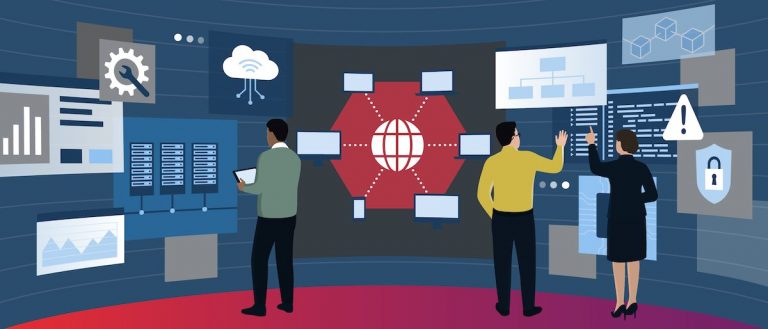
In today’s digitally connected world, where everyone expects high-speed and reliable connections for their data-intensive activities, quality of service (QoS) plays the starring role. Think of QoS as the traffic cop of the digital highway, ensuring that data gets where it needs to go smoothly and quickly. For service providers, QoS is more than just traffic management. It’s a way to ensure customer satisfaction, differentiate their services and ultimately succeed in the ever-competitive telecommunications market.
To easily expose these QoS capabilities to customers and third-party developers, CableLabs is working with CAMARA to publish a set of intent-based APIs. CAMARA is an open-source project hosted by the Linux Foundation, with active participation from service providers, third-party developers, hyperscalers and a diverse vendor ecosystem. GSMA is standardizing many of the CAMARA APIs as a part of its Open Gateway initiative, providing a path to market and adoption for these services.
This work was an open collaboration with CAMARA and the participating companies as they continue to embrace wireline technologies. The CAMARA community provides an easy path for operators and developers to contribute and consume network APIs. More engagement from wireline operators will drive this further.
The Game-Changing Extension
Before we delve into the details of intent-based APIs and CAMARA, I’d like to highlight CableLabs’ recent contribution and demonstrate why we think it’s an important milestone in the continuous network transformation that our members are undergoing.
As you may be aware, CableLabs’ member companies frequently have fiber and mobile offerings in addition to their DOCSIS® networks. Each of these networks has a variety of mechanisms for managing QoS settings and establishing Quality on Demand (QoD) sessions. Although we want to expose these capabilities to end users, we don’t want to expose the added complexity. The changes we’re introducing allow for virtually any QoS profile to be defined using a common set of attributes that will work across both wireless and wireline networks. Before our QoS profile contribution, only four predefined profiles were available, and they didn’t map well to wireline offerings.
The initial profiles were also based on general guidance and didn’t provide a specific set of capabilities. This isn’t a criticism of the initial work. It was a great start, and these APIs are still in an alpha release. That means that the APIs are still in the early phases of development, and we expect additional changes before a stable release happens.
Details of the CAMARA Quality on Demand API
The CAMARA Quality on Demand API is available here. The purpose of this API is to dynamically manage QoD sessions for specific devices or traffic flows.
Readers who are familiar with developing web services will be familiar with the diagram below, showing the three methods for managing a QoS session. The methods are as follows:
- Create session (POST)—Requests that the service provider establish a new QoS session based on the device and subscriber identification information and the unique name for the QoS profile for a given duration.
- Get session (GET)—Retrieves the information about a session based on its session ID.
- Delete session (DELETE)—Terminates a session before it has expired.
In addition to defining the calls above, the API defines all the required and optional attributes associated with each call. This is all written using OpenAPI version 3.0.3. The benefit of using OpenAPI is that there are dozens, if not hundreds, of tools out there to generate code based on OpenAPI descriptions.
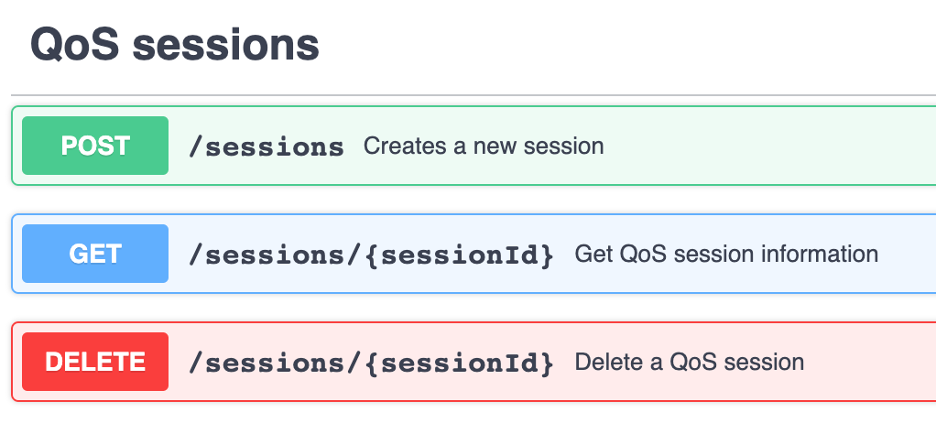
Details About QoS Profile Attributes
These new QoS attributes are intended to describe most QoS profiles across a wide variety of wireless and wireline networks. Each of the network types describes quality of service in the exact same way. The CAMARA QoS Profile has distilled these settings into a common set of attributes that can be applied across a broad set of access networks. Since these attributes are defined by the services provider, the provider can choose a subset of these capabilities to expose. It’s important to read the definitions of these attributes in the CAMARA Quality on Demand API before you use them since these definitions may vary slightly from a specific access network implementation.
We’ve added 15 attributes for QoS profiles. Don’t let that overwhelm you; only the name and status are required. The list of attributes is here, with detailed descriptions provided in the QoD API specification.
- name
- description
- status
- targetMinUpstreamRate
- maxUpstreamRate
- maxUpstreamBurstRate
- targetMinDownstreamRate
- maxDownstreamRate
- maxDownstreamBurstRate
- minDuration
- maxDuration
- priority
- packetDelayBudget
- jitter
- packetErrorLossRate
Benefits of Open Source
One of the great advantages of this project’s open-source nature is that these APIs are available to anyone to try. There’s no need to wait for a stable release or an official product to kick the tires on these APIs. Anyone can download them today and use give them a try.
In fact, that’s how CableLabs started working with CAMARA. As part of a “Speed Boost” proof of concept to highlight the convergence architecture, we needed an API that provided many of the capabilities that CAMARA offers. The initial “Speed Boost” used the version of the CAMARA Quality on Demand API that was available at the time. We’ll expand on this more during SCTE Cable-Tec Expo ’23 in October.
Through our work with the APIs, we found opportunities to make improvements. The CAMARA community was very welcoming to and supportive of our contribution. These changes have now been merged into the 0.9.0 release.
Next Steps
We’re already working on extensions to the Quality on Demand API to allow for a richer set of query capabilities to find the QoS profile that meets individual needs. Please provide feedback and support for these features here and here.
Stay tuned for more updates about CAMARA, the GSMA Open Gateway initiative and CableLabs’ continued contributions to the telecommunications sector. These entities are working together to shape the future of telecommunications, and it’s an exciting time to watch this transformation unfold.

Convergence
Up Ahead: Better Connections, Happier Users and Lower Costs

Whether at home, in the office, at a coffee shop or on the go, we all expect a dependable internet connection. Even when we're offered bundled services that combine wireless and wireline network access, uninterrupted connectivity often isn't as straightforward as it sounds. Simply providing connectivity over multiple access network types isn't sufficient for meeting customers’ expectations, and managing these as independent networks drives operational costs and complexity.
Wireless-wireline convergence (WWC) solves these problems for consumers and operators. WWC—or fixed-mobile convergence, as it’s sometimes called—enables ubiquitous connectivity that works seamlessly, meeting customers’ needs and simplifying network operations.
CableLabs is working with member and vendor communities to make this a reality. We’ve recently published a white paper that lays out the roadmap to WWC.
How Wireless-Wireline Convergence Works
The WWC architecture simplifies networks by eliminating redundant capabilities that exist across wireline and wireless access networks and enabling seamless operations across access technologies. These redundancies, which include subscriber databases, routing function and security capabilities, are converged under the WWC architecture.
At the heart of the WWC architecture is a single converged core based on the 3GPP 5G mobile core. The mobile core was selected as the foundation for the converged core over wireline cores since mobile cores support devices moving across access networks.
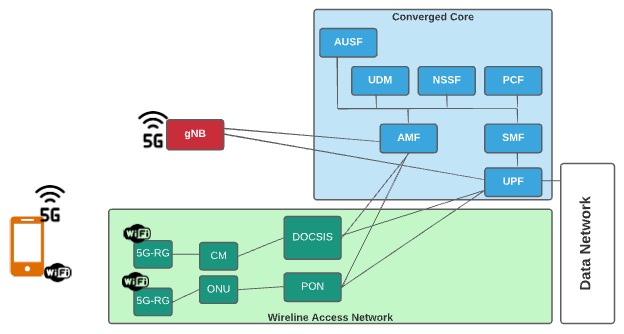
Under the WWC architecture, a single converged core will enable seamless wireless access across Wi-Fi and cellular networks.
When Will Network Convergence Become a Reality?
We’d all like to snap our fingers and begin reaping the benefits of a fully converged network tomorrow. However, because of a substantial installed base, as well as gaps in current products, standards and specifications, this is going to be a journey. Fortunately, the foundation for WWC is already being delivered with help from current technologies.
CableLabs’ member and vendor collaboration will help resolve the gaps in converging DOCSIS® networks, passive optical networking (PON) and Wi-Fi with mobile networks. Existing CableLabs and other industry specifications will be updated and extended, and new specs will be developed.
We’ve mapped out the WWC roadmap into three general phases—starting by connecting what is deployed today and progressing towards fully converged networks.
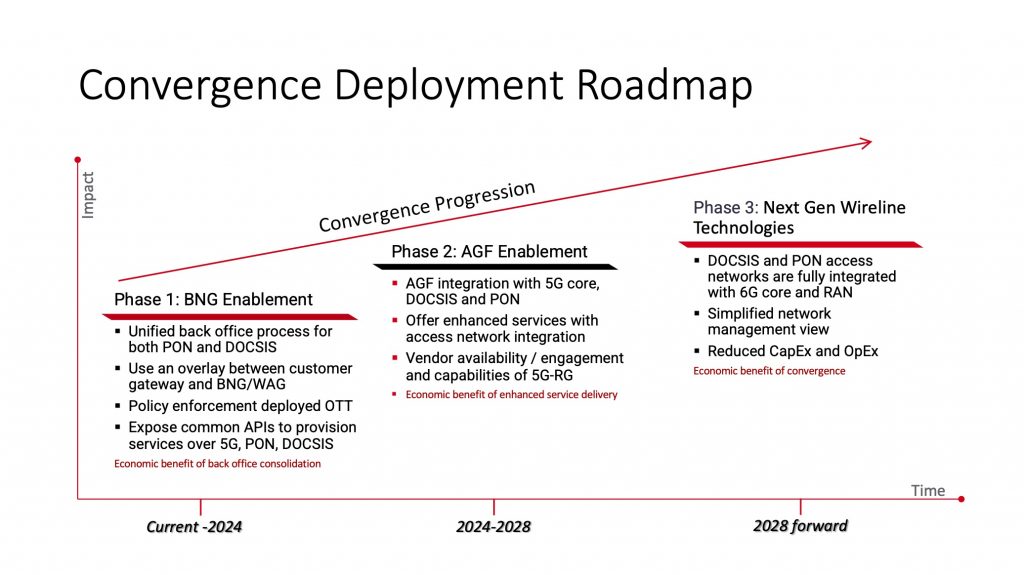
The roadmap evolves toward a complete integration of wireline and wireless networks, beginning within the decade.
To go deeper and learn more about WWC, the phases of the deployment roadmap and what fixed-mobile convergence means for our end-user experience, check out the new white paper.

Convergence
Driving 5G and HFC Convergence with Multi-Tenancy at the Edge
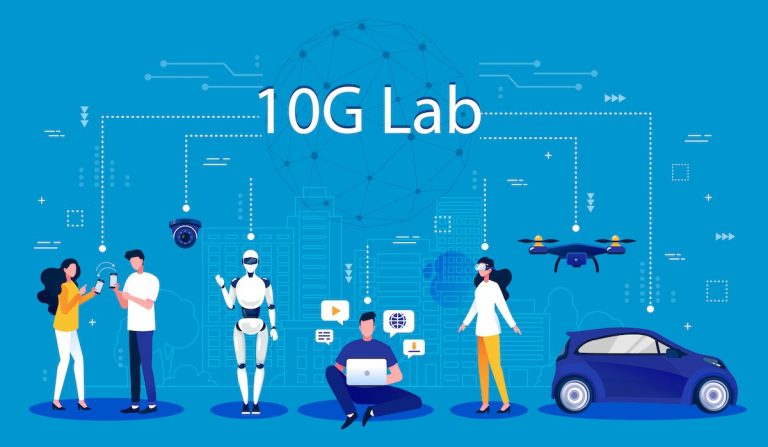
CableLabs is making it easier and more efficient to run 5G, DOCSIS and other applications at the edge. Working with our vendor partners, we’ve remediated challenges and improved the way vendors deploy their cloud-native 5G network stacks into a shared, private cloud setting. This early work acts as a catalyst to a vision in which any application workload can be co-located on infrastructure at any location in an operator’s footprint that serves the applications in the most optimal way.
The 10G Lab
CableLabs launched the “10G Lab” where the goal is to deploy multiple 5G cores and vRAN systems alongside a cable hybrid fiber-coax (HFC) network. More specifically, these applications will run in a cloud-native, multi-tenant, bare-metal environment that starts the journey toward a fully converged network. By co-locating 5G and HFC running as containers on shared infrastructure managed by a common management layer, this first step toward platform convergence enables operators to reap the rewards that come with this type of architecture, including:
- reduced operating expenses (OpEx), such as power consumption, and reduced capital expenses (CapEx), including hardware costs and facilities to house the hardware, such as head-end or hub locations;
- the elimination of over-provisioned environments by matching resources to demand (the environment is scaled to optimize network stack operation);
- automated as opposed to manual deployment of services (more OpEx savings); and
- the ability to create dynamic, customized network topologies at different geographical locations that improve throughput and reduce latency for subscribers.
In addition, decoupling the network software from proprietary hardware increases the cadence of system upgrades, which reduces the time to market for new capabilities and optimizations.
The following diagram shows the current and future focus of the 10G Lab:
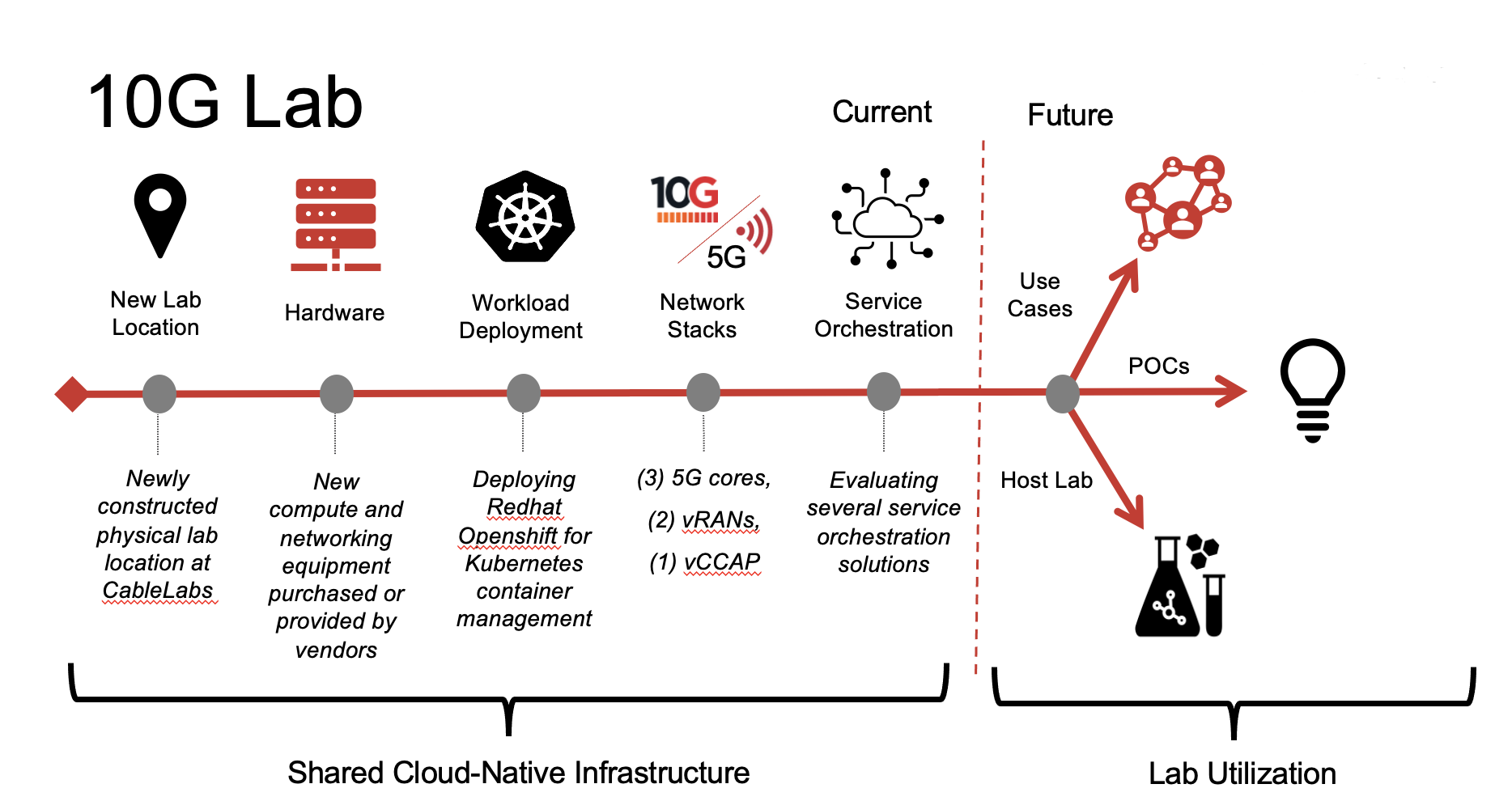
The Experience
CableLabs’ experience working with vendors to deploy network stacks into a multi-tenant environment, initially 5G, has been captured in a recently published white paper (open to the public) entitled “Best Practices for Deploying 5G into a Shared Environment.” There’s also a GitHub repository (referenced in the white paper) that shares the scripts for automating the deployment of a Kubernetes cluster tailored for 5G workloads. The white paper captures learnings related to enhancing security and ensuring that vendor applications are deployed such that they don’t interfere with one another when running in a shared environment. Other areas of discovery include optimizing network configurations, balancing resource allocations, enabling performance settings (particularly for user-plane operations for 5G) and easing the management of multiple applications on shared infrastructure. Be sure to check out the conference recording on this topic at the Envision Vendor Forum 2022 (day 2).
What’s Next
CableLabs has already worked with 5G vendors in the 10G Lab; however, later this year, we plan to expand the lab capabilities with open-source 5G cores and vRAN solutions, as well as a vCCAP. When a level of convergence is achieved—initially through co-locating the 5G and HFC network stacks into a shared environment, and eventually by establishing a tighter integration between 5G and cable wireline technologies through a shared core to support both access network types—operators will further benefit from this singular, multi-modal communication platform that will reduce network complexity, cut operational costs, improve quality and create new business and service opportunities.
Get Involved
The 10G Lab will play a part in three key initiatives. It will:
- provide a foundation for convergence-related activities, including executing convergence use cases of interest to our members;
- provide an environment for hosting the 5G challenge and other interoperability events; and
- be leveraged for proof of concept (POC) demonstrations as part of CableLabs’ innovation initiatives.
The 10G Lab is open to collaboration with CableLabs’ members and the NDA vendor community. We encourage members and vendors to partner with us to showcase the value of running applications in this shared, cloud-native environment. Please contact Carmela Stuart with your ideas! You can also join the CableLabs community as an NDA vendor.

Convergence
Achieve Seamless Access with Converged Access Edge Controller (CAEC)

Imagine a world in which end users no longer worry about which network they’re connected to because the most optimal connectivity for any given moment is automatically provided. This connectivity consists of one or more seamlessly combined network connections, intelligently customized by a multitude of factors, such as application requirements, user priority and network status. CableLabs believes convergence will be the driving force in making this world a reality and is working on solutions to enable it. Converged Access Edge Controller (CAEC) is one of those solutions.
How Does CAEC Work?
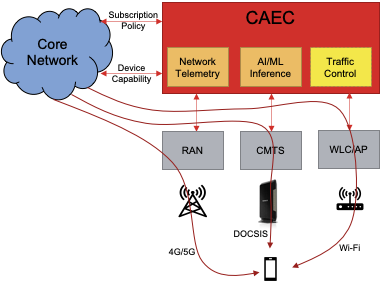
CAEC facilitates the converged use of HFC, Wi-Fi and mobile access technologies to optimize the use of network assets to deliver a seamless user experience. The controller dynamically switches, steers, or splits subscribers' data traffic across the available access links based on subscribers' device capabilities, subscription profile and real-time telemetry data of each access link, such as utilization and link quality.
For example, CAEC can be programmed to optimize the transport cost without degrading the perceived user experience. Households closer to the mobile site could primarily be served via wireless access link; CAEC will transparently switch them to HFC access link in the event of temporary congestion on that site to avoid degradation in the user experience. Similarly, households farther away from the mobile site could primarily be served via the HFC network, and CAEC could split the traffic between HFC and wireless upon onset of congestion in the HFC infrastructure. In another use case, the CAEC algorithm can be optimized to provide an instantaneous bandwidth boost by combining the available accesses based on device and subscription policies.
CAEC’s Modular and Extensible Architecture
CAEC offers powerful, near real-time traffic bonding, steering, and splitting capabilities across multiple access technologies managed by a single operator (i.e. multiple system operator). CAEC sports a microservices-based architecture consisting of three main services; network telemetry, AI/ML inference and traffic control. CAEC’s modular design and open APIs allow it to easily interoperate and complement other network services. For example, CAEC can be implemented as part of standardized network services such as O-RAN Alliance’s RAN Intelligent Controller (RIC) and 3GPP’s Network Data Analytics Function (NWDAF). The CAEC platform is extensible to run customized machine learning models to identify the patterns in network behavior that are often tough for operators to identify. The platform also provides operators the flexibility to develop and implement their own traffic control algorithms.
There are alternative solutions to provide converged access that aggregate mobile and Wi-Fi traffic on capable client devices. For example, 3GPPP has defined an access aggregation specification called Access Traffic Steering, Switching & Splitting (ATSSS). Additionally, several companies are offering cloud-based solutions similar to ATSSS. CAEC can complement these solutions by providing near real-time directions to steer, switch or split the traffic based on a combination of AI/MI models and network intelligence. Converged Access Edge Controller can also provide valuable insights for proactive network maintenance based on real-time statistics analysis and pattern identification within the network.
Learn More
If you need more information or have any further questions, please feel free to reach out to Arun Yerra – Principal Mobile Architect, CAEC Project Lead (a.yerra@cablelabs.com).

Convergence
Converged Service Management Layer (CSML) Completes the Operations Convergence Puzzle

Traditionally, telecommunications networks operate in siloes running specialized physical hardware functions for each domain (radio, access, transport, core, and data center), and they’re managed by proprietary element management systems. Operators who have both wireline and wireless networks, for example, run the networks on separate infrastructures and manage them independently. For that reason, designing, deploying, and operating end-to-end services can involve lengthy and manual processes resulting in longer lead times (weeks to months) until effective service delivery.
But the networks of tomorrow are envisioned to operate multiple different physical and cloud- native functions over a single flexible, programmable convergence platform whose hardware, software and data storage resources are shared across multiple access technologies. And a key building block of convergence is operations convergence, implying a common operations framework for deploying, configuring, and managing network functions constituting a service.
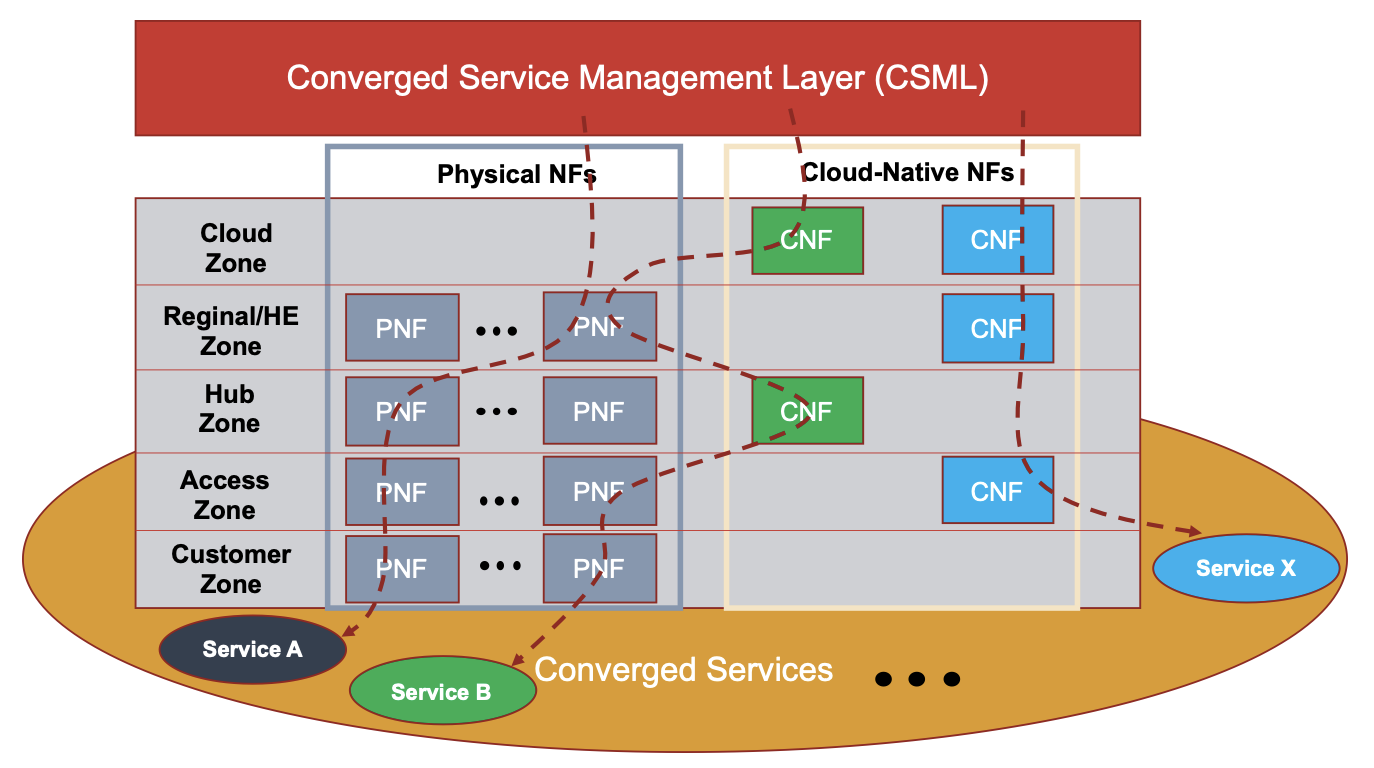
The Converged Service Management Layer (CSML) Project
When it comes to solving these challenges, technologies like software-defined networking (SDN) and network functions virtualization (NFV) have already addressed certain pieces of the puzzle. SDN separates the data plane (network traffic) from the control plane (signaling/routing traffic) to enable flexible, coordinated control, and NFV decouples network and service functions from the underlying hardware. In addition, cloud computing provides an efficient means to utilize the infrastructure and make all these goals achievable. But a converged service operator needs to have the ability to model end-to-end services and to abstract and automate the control of physical and virtual resources.
CableLabs’ CSML project —the final puzzle piece in the operations convergence puzzle—began in response to the rising need for a common automation platform for different network lifecycle processes. The CSML implementation consists of an open-source orchestration platform —Open Network Automation Platform (ONAP) —and additional utilities developed by CableLabs to onboard service use cases. The project activities are broadly divided into three categories:
- Service design involves specifying end-to-end services composed of multiple network functions (NFs) called xNFs. The model-driven approach helps with extending and reusing software artifacts for various use cases.
- Service deployment involves automated instantiation, modification and removal of network services over both physical and virtual infrastructures.
- Service assurance involves a vendor-agnostic monitoring and analytics framework for closed-loop management.
The use cases that are currently being designed and developed aim to either improve existing operational processes or demonstrate advanced orchestration and automation capabilities through new service concepts. For example, by converging both service and the underlying network data, operators are able to better extract and exploit the correlations between the two. Advances in machine learning can be applied to this converged data source to drive service automation and assurance features such as proactive network maintenance (PNM), auto-healing, or service resiliency and optimization.
CSML’s Long-Term Goals
The broader goals of the CSML project are to drive the adoption of network automation, virtualization and operations convergence at scale. Also, as the transition to NFV is progressing, the project aims to demonstrate how physical network elements can be harmonized with virtual elements to preserve exiting network investments. The use cases demonstrated by the project will provide a blueprint for a flexible, agile service platform, powering both existing and new innovative services while reducing cost and operational complexities.
If you need more information or have any further questions, please feel free to reach out to Rahil Gandotra, Senior SW Architect and Converged Service Management Layer Project Lead (r.gandotra@cablelabs.com).

Convergence
Introducing Evolved Mobile Virtual Network Operator (MVNO) Architectures for Converged Wireless Deployments

As smartphones and tablets continue to proliferate, seamless connectivity is becoming an integral part of a wireless operator’s service offering—as well as a competitive imperative. Recognizing the evolution of the mobile industry landscape, and driven by the introduction of 5G and the availability of new and innovative spectrum options, CableLabs and its members initiated a technical working group (Dec. 2020-Aug. 2021) to create an evolved architectural blueprint for mobile virtual network operators (MVNOs). The working group’s aim was to explore new converged architectures that will benefit our members’ wireless deployments while highlighting the benefits, impacts to existing deployments and features needed to be supported by both mobile network operator (MNO) and MVNO networks.
Background
Many traditional broadband services providers—also known as multiple system operators (MSOs)—might not own mobile infrastructure but have (or are in the process of negotiating) MVNO arrangements with MNOs. These kinds of arrangements allow them to bundle fixed and mobile broadband services into a single service package. Traditionally, most MSOs adopt a reseller-type “Wi-Fi first” MVNO, where the MVNO doesn’t own any mobile network infrastructure and resells the services leveraging MNO infrastructure.
Emergence of a New MVNO Model
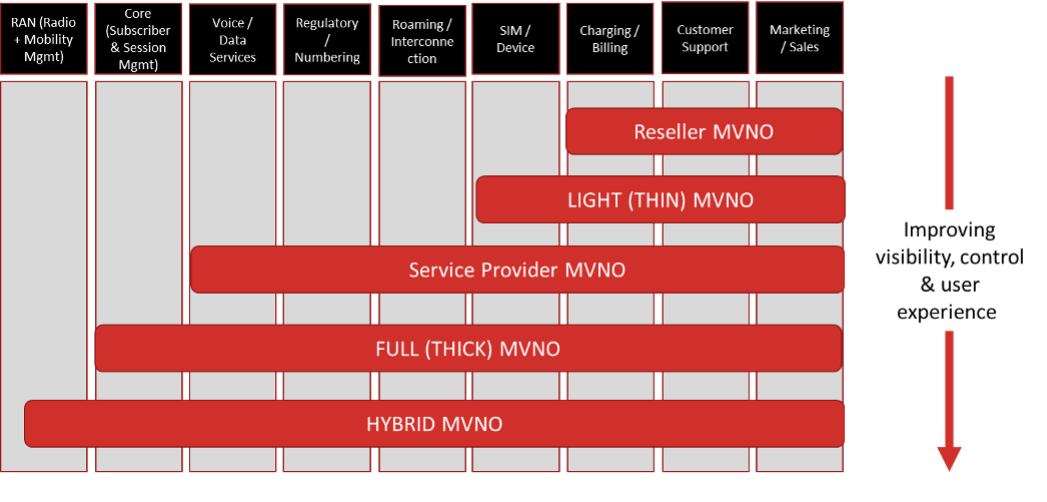
The MVNO models vary based on the amount of mobile network infrastructure that the MVNO owns and the degree of control over the management of different aspects of MVNO subscriptions and their service offerings. One common aspect of all traditional MVNO models is leveraging the radio access network (RAN) of a partner MNO.
With the advent of 5G and the availability of shared spectrum, many MSOs are actively evaluating offload opportunities for enhancing MVNO economics and are contemplating deploying their own mobile radio infrastructure in specific geographic areas (in addition to their substantial Wi-Fi footprint).
Such MSOs now have to contend with three disparate sets of wireless infrastructures:
- the MSO’s community Wi-Fi network,
- the MNO’s 4G/5G network, and
- the MSO’s own 4G/5G network.
This creates a new type of MVNO model called hybrid-MVNO (H-MVNO) that enables MVNOs to offload their subscribers’ traffic from the MNO network—not just to their Wi-Fi networks but also to the MVNO-owned mobile network when inside the coverage footprint of their wireless network(s).
Maximizing data offload via the H-MVNOs’ own wireless assets—thus ensuring a consistent user experience and enforcing uniform and personalized policies as users move in and out of coverage of these three networks—will require the deployment of new converged network architecture and related capabilities.
Dual-SIM Architectures Evaluated by the Technical Working Group
Leveraging dual-SIM devices (devices with the ability to simultaneously connect to two networks) to realize this network convergence is the one way for an H-MVNO to maximize the use of its own network. Dual-SIM device usage allows the H-MVNO to leverage the existing reseller-type MVNO arrangements and require minimum interaction between the H-MVNO and MNO core networks.
However, leveraging the reseller MVNO with dual-SIM capabilities doesn’t offer the H-MVNO any real-time insights into their subscribers’ data usage statistics and patterns. Also, H-MVNOs have no control over policy, subscriptions, mobility or user experience management when their subscribers are outside H-MVNO network coverage.
This formed the basis of evaluating the new evolved Dual-SIM Dual Standby (DSDS) architectures, which leverage standardized 3GPP interfaces to overcome some of the limitations of the traditional reseller MVNO and provide more control to H-MVNOs with regard to policy, subscription and user-experience management by anchoring all subscriber data traffic in a common anchor within the H-MVNO network.
Voice handling with dual-SIM devices can be simplified by leveraging the MNO SIM and network for carrying voice traffic at all times, while prioritizing H-MVNO network (when available) for data traffic.
Single-SIM Architectures Evaluated by the Technical Working Group
Unlike architectures with dual SIMs, single-SIM devices allow the H-MVNO network to enable seamless low-latency mobility for data applications across the MNO and H-MVNO networks. An ideal architecture for offering mobile services with single-SIM device usage is to combine the roaming architecture and a mobility interface, both of which are standardized in 3GPP.
However, due to the targeted nature of H-MVNO mobile deployments, the signaling load can increase on MNO mobility management core network elements, as the H-MVNO subscribers move in and out of H-MVNO network coverage.
To overcome this problem, we evaluated new MVNO architectures that make use of dedicated network elements within the MNO domain to serve H-MVNO subscriber traffic, thereby isolating it from the MNO subscriber traffic and eliminating the increase in signaling load on core network elements that serve MNO subscribers.
In addition, we evaluated voice handling in scenarios where H-MVNOs don’t want to deploy their own voice platforms. One option is to offer voice via a third-party voice service provider; another is to enable additional interfaces between the MNO and the H-MVNO network to leverage the MNO’s voice platform.
Go Deeper
If you have any further questions, please feel free to reach out to the MVNO Interconnect Technical WG Lead, Omkar Dharmadhikari (o.dharmadhikari@cablelabs.com).
For more information, please visit:
- Mobile Summit Session #2 MVNOs (November 2020)
- MVNO Interconnect Phase 1 White Paper (May 2021)
- Evolved MVNO Architectures for Converged Wireless Deployments paper and presentation at SCTE Expo 2021 (October 2021)
- CableLabs Webinar on Evolved MVNO Architectures for Converged Wireless Deployments (October 2021)

Convergence
CableLabs Announces the Convergence Council

Motivational speaker, Jim Rohn is known for saying, “What is powerful is when what you say is just the tip of the iceberg of what you know.” For an organization like CableLabs, the challenge morphs into something quite monumental when the goal is to enable convergence across multiple industries and technologies that have been progressing independently of one another.
So, CableLabs is trying something new this year.
As part of our ecosystem expansion program, CableLabs has created the Convergence Council that will be hosted by CableLabs' Chief Research and Development Officer (CRDO) Mariam Sorond. The Convergence Council is an advisory board, composed of a broad range of experts and thought leaders representing multiple aspects of connectivity—whether it’s wired, wireless, mobile, fixed technologies—or the enablers of these technologies through cloud and virtualized platforms while embracing open and disaggregated architectures. This brilliant team of evangelists is tasked with identifying convergence use cases that will inspire development, technologies and solutions, business models that could unlock opportunities for convergence, and building scenarios for industry consensus.
“Tomorrow’s consumers are slated to be more connected, informed, and creative than ever before.” Sorond says. “To that end, we are moving towards more user-centric networks that will need a fresh look at convergence to enable not only the demands of a seamless user experience but also an unleashing of new applications. To speed the industry’s understanding of use cases that will drive this vision, I wanted to create an industry-sounding board from as broad a sample of thought leaders as possible to help us explore some of the more complex areas.”
CableLabs looks forward to working with these talented individuals to move this important initiative forward. The Convergence Council will also be working very closely with the newly announced Mobile Convergence Committee to ensure a comprehensive industry engagement on our future work.
Many of the participants in the council have expressed strong support of the Convergence Council and convergence in general.
Says Rob Soni, Head of Architecture and Technology at Nokia/Bell Labs, “The future of Mobile Access Networks will be to lean forward towards virtualized and disaggregated platforms. These platforms will be flexible and maximize user and enterprise experience. This will give great opportunities between cable operators and mobile operators to cooperate in many ways in the 5G era. Leveraging transport, platforms, and common technologies are all opportunities for greater cooperation between different types of operators that minimize the total cost of ownership. “
“Cable providers will play a critical role in the era of 5G and the edge,” says Caroline Chan, VP and GM, Network Business Incubator Division, Intel. “Convergence is essential for ensuring consistent service and persistent connectivity.”
“CableLabs has recognized the need for a convergence strategy, and we’re honored to participate in the development of a common vision and strategy,” says John Baker, Senior VP, Business Development, Mavenir. “Unifying the layers of wireless and cable infrastructure offers a significant opportunity. Convergence will allow for simplification in the deployment and operation of converged solutions.”
Steve Alexander, CTO, Ciena, sums up the opportunity behind convergence: “Cable access digitization and transition to cloud is a ripe environment for bandwidth-rich solutions,” he says. “Intelligence and convergence will enable myriad end-to-end services and a seamless user experience.”
The following ecosystem partner representatives are on the advisory council this year:
- Caroline Chan, Intel, VP, GM Network Business Incubator Division
- Dan Rabinovitsj, Facebook, VP Telco Strategy
- Len Dauphinee, MaxLinear, CTO, Broadband Products
- John Baker, Mavenir, SVP, Business Development
- John Chapman, Cisco, CTO Broadband Technologies & Cisco Fellow
- Robert Soni, Nokia-Bell Labs, Head of Architecture and Technology
- Sachin Katti, Stanford University, Assistant Professor, Wireless Technology
- Shawn Hakl, Microsoft, VP, 5G Strategy
- Shlomo Rakib, Cohere, Founder & President
- Stephen Alexander, Ciena, CTO
- Taher Behbehani, formerly Samsung, SVP and GM, Mobile B2B
- Tom Cloonan, CommScope, CTO Cable Solutions
You can learn more about and hear directly from Convergence Council members by registering for CableLabs’ Envision Vendor Forum 2021: Mobile & Convergence.

Convergence
CableLabs Announces the Mobile Convergence Committee: User-Centric Networks of the Future Need a Fresh Look at Convergence

Over the next decade, we expect the industry to undergo a significant transformation as service providers deploy multiple access technologies and as new connectivity choices become available to users. To enable transparent, seamless connectivity for users and to efficiently leverage their assets, networks need to become more user-centric. User centricity will demand a more holistic architecture that converges the independent, siloed networks we currently use, thereby enabling a more seamless and optimized experience at home, at work, on the go and in the air. The time is now to put on an innovative lens to take a fresh look at convergence.
Although many people are focused on expanding from wired to wireless, and integrating existing wired and wireless networks, no single access method can address the needs of all users. Ideally, a converged network solution will enable our members to deliver the most efficient seamless experience while allowing them to keep up with ever-increasing demand for faster, more reliable, more secure connectivity—all in an effort to improve the way we live, work, learn and play and to unleash the next generation of applications and use cases.
This transformational shift toward user-centric networks as wireless and wireline technologies surge toward deployment, the CableLabs team, led by Chief Research Development Officer (CRDO) Mariam Sorond, formulated a clear vision of what network architectures and technologies for such a converged network should be.
“With the rapid adoption of new disaggregated architectures, open standards and cloud native technologies,” Sorond said, “the timing seemed right to focus on a user-centric network architecture through the convergence of wireless and wired networks.”
A well-defined set of architectures and requirements will provide a clear and consistent view and facilitate industry alignment and economies of scale. It will also provide guidelines for ecosystem partners to develop converged solutions and products, enabling our members to deliver on the vision of user-centric networks. To this end, Sorond has put together the Mobile Convergence Committee (MCC), the main objective of which will be to develop industry requirements for a network that will, in turn, bolster the convergence architecture and its specifications.
Currently, the MCC is composed of the following ten industry influencers and thought leaders:
- Eben Albertyn (VodafoneZiggo)
- Nadia Benabdallah, Vice-chair (Vodafone)
- Craig Cowden, Chair (Charter)
- Elmar Grasser (Sunrise/Liberty Global)
- Tony Krueck (Cox)
- Tom Nagel (Comcast)
- Brian O’Shaughnessy (Shaw Communications)
- Luciano Ramos (Rogers Communications)
- Xavier Rocoplan (Millicom)
- Iyad Tarazi (Federated Wireless)
We anticipate that MCC membership will expand to a total of 14 in the coming months.
“The advantages of convergent networks is clear, and it will strongly benefit our customers,” said Nadia Benabdallah. “We will simplify the consumption of new services, regardless of the underlying infrastructure. With the adoption of the ‘Network as a Platform’ approach, we make the underlying networks invisible to our customers.”
“The long-term vision for fixed mobile convergence is to deliver ubiquitous wired-wireless connectivity to our customers anywhere and on any device, delivered on cable’s high-capacity and low-latency networks,” Craig Cowden said. “This means that customers will carry their services, policies and identity with them wherever they go. The time for convergence is now, as we can leverage key building blocks like virtualization, network disaggregation, open interfaces, multi-access edge computing (MEC), automation, along with artificial intelligence (AI) and machine learning (ML) to manage network complexities. I look forward to chairing the Mobile Convergence Committee and working with a talented group of professionals.”
“At Cox,” said Tony Krueck, “our number-one guiding principle for considering retail wireless is to protect our core business. We believe the primary way to do that is through converged capabilities. Creating seamless connectivity and applications for our customers will become foundational to the future of our products and services.”
“With Xfinity Mobile, Comcast has taken its leading connectivity experience outside the home and given our customers the ability to access the Internet from anywhere,” said Tom Nagel. “As we look toward a future with more integrated experiences across all of our services, we are excited to work with CableLabs toward the virtualization and convergence that will help make that a reality.”
“We believe that bringing together a common vision and strategy in wireless, cable infrastructure and—most importantly—customer experience is critical to moving the industry forward,” said Luciano Ramos. “As members of CableLabs, we’re very pleased to participate in the Mobile Convergence Committee to help simplify converged solutions and bring new experiences to customers.”
“The industry has been talking about convergence for a long time”, said Iyad Tarazi. “What’s exciting about this CableLabs initiative is that the foundational technologies now exist for us to make this real, and the focus on the customer experience is the right guiding principle.”
If you’re interested in hearing more about the MCC, register for Envision by clicking below.


